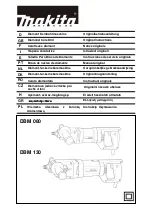
8
Assembly, Operation & Maintenance Instructions
OPERATING INSTRUCTIONS
GENERAL INSTRUCTIONS
A fairly protected location is desirable for pleasant and efficient cooking. Try to keep the
barbeque sheltered from strong winds as this will drastically reduce cooking efficiency. If
this is unavoidable, position the length of the barbeque to be parallel in the direction of the
wind. Keep the barbeque level. Check frequently that the burner remains alight when used
in conditions of strong wind (through the viewing hole on the left hand side of the chassis
or through open grills). Make sure the minimum distances of the barbeque to any wall or
combustible surface are met, and that when not using the stand, the supporting surface
can withstand the heat. When using the stand, take care that the barbeque is locked in
position using the locks on the castors & the hose is not touching any hot surface.
GAS TYPE AND CONSUMPTION
The barbeques are designed to operate on Propane and/or Butane gas only. Gas
consumption, Pressure and Injector Orifice sizes are shown on the Data Plate found under
the right hand servery.
GAS CONTROL KNOB
The gas control knob locks in both the
Off
and
High
positions. By depressing the knob
and turning anti-clockwise, gas flow will gradually increase until the
High
position is
reached. Continue turning in this direction and gas flow will decrease until a simmer level is
reached at
Low
. To turn gas flow off, the gas control knob must be turned clockwise from
Low
, depressed at
High
and turned until the
Off
position is reached.
MATT VITREOUS CAST IRON OPEN GRILLS AND SOLID
PLATE
The FORCE
TM
2 burner and FURNACE
TM
3 burner barbeques are supplied with open grills.
A flat, solid plate is available as an accessory for the FURNACE
TM
for the right hand side
(this is the recommended general grill and plate configuration which will reduce the heat
flowing over the control knobs). The FURNACE
TM
3 burner barbeque has the option of a
central teppanyaki plate or a flat, solid plate for the right hand side. Note that the grills and
plates used on either barbeque cannot be used on the other model and a maximum of one
grill plate should be exchanged for a plate at any time (only one plate installed). The open
grills have a solid strip of cast iron built into the bottom of the grill used to protect the
burner from dropping oil or food. The grills are fitted onto the supports built into the inside
of the chassis. When correctly allocated, there should be a 5-6 mm gap between the grills,
and the inner edge of the chassis. Any excess fat or liquid will flow into the chassis and
drip through the barbeque into the fat tray and foil tray below the chassis. If burner ports
become blocked, let the barbeque cool down & clean the burner with a wire brush. For a
list of accessories go to the Everdure by Heston Blumenthal website.
NOTE:
The enamel coating can be damaged by steel utensils. Damage to plates and
grills due to the use of metallic or sharp objects will not be covered under warranty. It is
recommended to use silicone cooking utensils as these are both hygienic and withstand
high temperatures.
FAT TRAY
Prior to use, check that the fat tray is clean and lined with a disposable foil tray. Use only
foil trays supplied for the barbeque, as trays of an incorrect size or height could cause
problems with aeration to the barbeque or spilled fat and oils. Make sure the fat tray
assembly is fully installed under the barbeque before operating the appliance.
UNDER NO CIRCUMSTANCES MUST SAND, KITTY LITTER OR FAT
ABSORBENTS BE USED IN THE FAT TRAY OR FOIL TRAY.









































